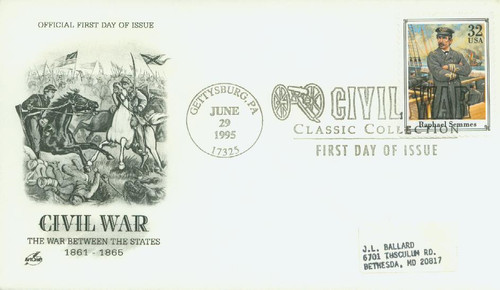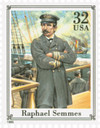
# 2975i - 1995 32c Civil War: Raphael Semmes
U.S. #2975i
1995 32¢ Raphael Semmes
Civil War
- Issued for the 130th anniversary of the Civil War
- From the second pane in the Classic Collections Series
- Declared the most popular stamps of 1995 by the USPS
Stamp Category: Commemorative
Set: Civil War 130th Anniversary
Value: 32¢, rate for first-class mail
First Day of Issue: June 29, 1995
First Day City: Gettysburg, Pennsylvania
Quantity Issued: 15,000,000
Printed by: Stamp Venturers
Printing Method: Photogravure
Format: Panes of 20 in sheets of 120
Perforations: 10.1
Why the stamp was issued: To mark the 130th anniversary of the end of the Civil War.
About the stamp design: The Civil War stamps featured artwork by Mark Hess, who had previously produced the artwork for the Legends of the West sheet. The USPS explained that they liked his painting style because of its “folksy stiffness,” that “emulates people standing uncomfortably in front of daguerreotype cameras.”
Raphael Semmes is pictured on his ship Alabama with a Union ship burning in the background. He’s shown facing away from the ship with his arms crossed.
First Day City: The official first day ceremony was held at the Gettysburg National Military Park in Pennsylvania, the site of one of the war’s most famous battles. Because they received a large number of requests, the USPS made the stamps available for sale across the country the same day.
Unusual facts about the Civil War stamps: The Civil War sheet was available by mail order in uncut press sheets of six panes. Of these, 20,000 were signed by stamp artist Mark Hess. The USPS also produced a set of postcards featuring the same images as the stamps (US #UX200-19). Imperforate and partially imperforate error panes have also been found.
About the Civil War Stamps: The Civil War stamp sheet featured 16 individuals – eight from the Union and eight from the Confederacy. The four battles in the corners included one victory for each side and two that are considered draws.
This was the second sheet in the Classic Collections Series following the famed Legends of the West sheet. Stamps in this series follow a similar format – 20 stamps, a decorative header, and information about each stamp printed on its back under the gum.
Plans for the Civil War sheet began while the 1994 Legends of the West sheet was still in its planning stage. The USPS believed that the Civil War was a natural addition to the new series and would be informational for the public. Initially the Citizens Stamp Advisory Committee rejected the idea, saying they should wait 20 years for the 50th anniversary of the war. But they were eventually swayed and the Civil War stamps were created. A group of historians were tasked with making a list of protentional subjects and Shelby Foote was hired to make the final selections. Foote was an expert in the Civil War, having written a three-volume history of the war and been featured in Ken Burns’ PBS documentary series on the war.
The USPS wanted the Civil War stamps to have more action to them – so only the two presidents were depicted in traditional portraits. The rest of the individuals were placed in the field or amidst an activity. After the Legends of the West mix-up, in which the Bill Pickett stamp mistakenly pictured his brother Ben, the USPS completely revamped their research process. The release of the 20 Civil War stamps marked the most extensive effort in the history of the USPS to review and verify the historical accuracy of stamp subjects. As Hess completed each version of his paintings, they were sent to a panel of experts who commented on the historical accuracy of everything from the weather to belt buckles.
Some of the people and battles featured in the Civil War sheet had appeared on US stamps before. This was also the second time the Civil War was honored – a set of five stamps (US #1178-82) was issued for the centennial in the 1960s. And from 2011-15, the USPS issued a series of stamps for the war’s 150th anniversary (US #4522/4981).
History the stamp represents: A lieutenant in the U.S. Navy, Raphael Semmes resigned his commission in February 1861 to run a purchasing mission for the Confederacy – actually buying armaments from manufacturers in New England and New York. In April he was placed in command of a Confederate ship, the CSS Sumter.
During a six-month cruise he seized 18 enemy ships before abandoning the Sumter in Gibraltar. Semmes then made his way to England, where he took command of the screw sloop CSS Alabama. Setting sail in September 1862, he embarked on a commerce-destroying cruise that would last nearly two years. Seizing and destroying nearly 70 ships in the mid-Atlantic, the Pacific, the Indian Ocean, and the Arabian Sea, Semmes made his way to Cherbourg, France. Engaged in battle on June 19, 1864, by the Union screw sloop USS Kearsarge, the Alabama was sunk off the coast of Cherbourg.
Semmes did not surrender with his ship, but instead managed to return home where he was placed in command of the James River squadron. When Richmond was evacuated in 1865, he burned his ships and, arming his sailors as infantry, surrendered with General Joseph Johnston at Greensboro, North Carolina.
U.S. #2975i
1995 32¢ Raphael Semmes
Civil War
- Issued for the 130th anniversary of the Civil War
- From the second pane in the Classic Collections Series
- Declared the most popular stamps of 1995 by the USPS
Stamp Category: Commemorative
Set: Civil War 130th Anniversary
Value: 32¢, rate for first-class mail
First Day of Issue: June 29, 1995
First Day City: Gettysburg, Pennsylvania
Quantity Issued: 15,000,000
Printed by: Stamp Venturers
Printing Method: Photogravure
Format: Panes of 20 in sheets of 120
Perforations: 10.1
Why the stamp was issued: To mark the 130th anniversary of the end of the Civil War.
About the stamp design: The Civil War stamps featured artwork by Mark Hess, who had previously produced the artwork for the Legends of the West sheet. The USPS explained that they liked his painting style because of its “folksy stiffness,” that “emulates people standing uncomfortably in front of daguerreotype cameras.”
Raphael Semmes is pictured on his ship Alabama with a Union ship burning in the background. He’s shown facing away from the ship with his arms crossed.
First Day City: The official first day ceremony was held at the Gettysburg National Military Park in Pennsylvania, the site of one of the war’s most famous battles. Because they received a large number of requests, the USPS made the stamps available for sale across the country the same day.
Unusual facts about the Civil War stamps: The Civil War sheet was available by mail order in uncut press sheets of six panes. Of these, 20,000 were signed by stamp artist Mark Hess. The USPS also produced a set of postcards featuring the same images as the stamps (US #UX200-19). Imperforate and partially imperforate error panes have also been found.
About the Civil War Stamps: The Civil War stamp sheet featured 16 individuals – eight from the Union and eight from the Confederacy. The four battles in the corners included one victory for each side and two that are considered draws.
This was the second sheet in the Classic Collections Series following the famed Legends of the West sheet. Stamps in this series follow a similar format – 20 stamps, a decorative header, and information about each stamp printed on its back under the gum.
Plans for the Civil War sheet began while the 1994 Legends of the West sheet was still in its planning stage. The USPS believed that the Civil War was a natural addition to the new series and would be informational for the public. Initially the Citizens Stamp Advisory Committee rejected the idea, saying they should wait 20 years for the 50th anniversary of the war. But they were eventually swayed and the Civil War stamps were created. A group of historians were tasked with making a list of protentional subjects and Shelby Foote was hired to make the final selections. Foote was an expert in the Civil War, having written a three-volume history of the war and been featured in Ken Burns’ PBS documentary series on the war.
The USPS wanted the Civil War stamps to have more action to them – so only the two presidents were depicted in traditional portraits. The rest of the individuals were placed in the field or amidst an activity. After the Legends of the West mix-up, in which the Bill Pickett stamp mistakenly pictured his brother Ben, the USPS completely revamped their research process. The release of the 20 Civil War stamps marked the most extensive effort in the history of the USPS to review and verify the historical accuracy of stamp subjects. As Hess completed each version of his paintings, they were sent to a panel of experts who commented on the historical accuracy of everything from the weather to belt buckles.
Some of the people and battles featured in the Civil War sheet had appeared on US stamps before. This was also the second time the Civil War was honored – a set of five stamps (US #1178-82) was issued for the centennial in the 1960s. And from 2011-15, the USPS issued a series of stamps for the war’s 150th anniversary (US #4522/4981).
History the stamp represents: A lieutenant in the U.S. Navy, Raphael Semmes resigned his commission in February 1861 to run a purchasing mission for the Confederacy – actually buying armaments from manufacturers in New England and New York. In April he was placed in command of a Confederate ship, the CSS Sumter.
During a six-month cruise he seized 18 enemy ships before abandoning the Sumter in Gibraltar. Semmes then made his way to England, where he took command of the screw sloop CSS Alabama. Setting sail in September 1862, he embarked on a commerce-destroying cruise that would last nearly two years. Seizing and destroying nearly 70 ships in the mid-Atlantic, the Pacific, the Indian Ocean, and the Arabian Sea, Semmes made his way to Cherbourg, France. Engaged in battle on June 19, 1864, by the Union screw sloop USS Kearsarge, the Alabama was sunk off the coast of Cherbourg.
Semmes did not surrender with his ship, but instead managed to return home where he was placed in command of the James River squadron. When Richmond was evacuated in 1865, he burned his ships and, arming his sailors as infantry, surrendered with General Joseph Johnston at Greensboro, North Carolina.








